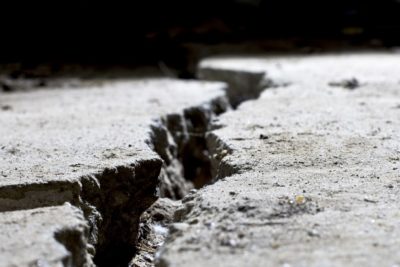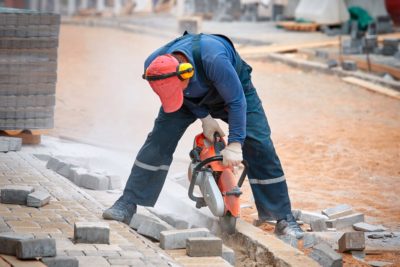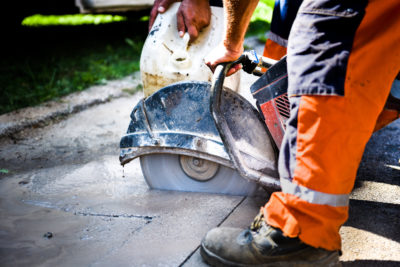What is it about concrete reinforcement that has everybody out on-site standing on their toes?
Steel reinforcement bars and mesh concealed within concrete structures help strengthen the concrete to support a great deal of weight and allow us to build some of the world’s most amazing buildings.
For this reason, cutting through steel reinforcement within concrete slabs has become a difficult task and requires the right equipment, expertise, and training to avoid the risk of injury, or worse.
In this post, you’ll learn about the different types of reinforcement products, their common uses, as well as tips on how to safely cut through reinforced concrete slabs.
But first…
What is reinforced concrete?
Naturally, concrete is strong against forces of compression, but weak in tension. With low tensile strength and flexibility, concrete steel reinforcement bars are recommended by engineers to improve both tension and compression, within concrete structures.
Steel reinforcement bonds well with concrete and helps to prevent and minimise concrete cracking under tension loads. Sharing similar thermal properties to concrete, ensures that the concrete is subjected to minimal stress during temperature changes, where it expands and contracts.
What is rebar?
Us Aussies love shortening words and giving things nicknames, the construction industry is no different. What is a rebar? Rebar is short for reinforcing bar, also known as steel reinforcement or reo bar, and is one of the most common types of steel reinforcement, in addition to steel reinforcement mesh, also known as reo mesh.
When do you need concrete steel reinforcement?
Rebar is used to increase the tensile strength of concrete slab and reinforced masonry structures and hold the concrete in tension. The rebar surface is often a deformed pattern which allows the concrete to adhere.
Not all projects require the use of concrete steel reinforcement, however, adding it will increase the concrete durability, compression strength and reduce the number of cracks that appear on the surface over time.
For commercial and industrial, large concrete structures or surfaces that are required to withstand large trucks, heavy machinery and traffic generally need concrete reinforcement. Areas that it is commonly found include:
- Paving car parks, airports, and other areas that uphold heavy traffic most of the time
- Types of precast concrete such as electric poles and railway sleepers
- Structural elements such as footings, beams, stairs and slabs
- Load bearing parts of structures including docks, harbours, and bridges
For residential, if your driveway is only expected to withstand the family 4×4, then you probably don’t need steel reinforcement bars. However, there is the option of welded wire mesh which is made into galvanised mesh panels, which is a common solution for residential driveways in preventing cracks.
Different types of concrete reinforcement
Galvanised dowel bars (reinforcing short steel bar)
Dowel bars are smooth reinforcing steel bars used in concrete joining to control and prevent cracking by allowing for movement in the joint due to shrinkage or temperature changes. They are available in a wide range of sizes including, 12mm, 16mm & 20mm.
Steel mesh (concrete steel mesh)
Reinforcing mesh is general purpose steel and is typically available as a rectangular mesh or square mesh sheets. Reinforcing mesh is most commonly used for residential house slabs, driveways, pathways, shed slabs, and provides crack control and core strength.
Trench mesh (concrete reinforcement mesh)
Trench mesh is a reinforcing mesh generally used in both residential and industrial buildings to reinforce concrete footings and beams. More specifically, trench mesh is used in residential footing trenches, with mesh sizes ranging up to 6m in length.
The benefits of reinforced concrete
- Improves compression strength
- Helps combat shearing, tensile and bending forces
- Increases durability
- Increases load bearing weight
- Helps minimise and prevent concrete cracking
- Forms a barrier to heat and sound
- Improves corrosion resistance
- More control over cross-sectional area
Tips to Cut Steel Reinforced Concrete
Cutting reinforced concrete can be difficult. You need the right tools and techniques to make sure you’re getting the best quality cuts that you can, without risk to injury. Some basic tips include:
- Work with a high standard of safety, includes wearing relevant safety gear, a proper respirator, and not just a dust mask, eye goggles, leather gloves, and steel cap boots
- Know what’s underneath the concrete you’re cutting. You don’t want to cut into plumbing, gas, or electrical components. Check blueprints or use concrete imaging technology, GPR Scanning, to check your concrete before you cut.
- Choose the right tools and machinery that will handle the job easily. Hydraulic hand cutters with a diamond blade are great for cutting through reinforced concrete slab and walls.
- Manage the dust on your worksite. Dust is a huge health risk, so take steps to control it.
If you’re looking for a specialist concrete cutting company who uses only the best practices and tools to get the job done right, call the experts at Diamond Cut Concrete on 08 9331 3600 or submit an enquiry through our website.



